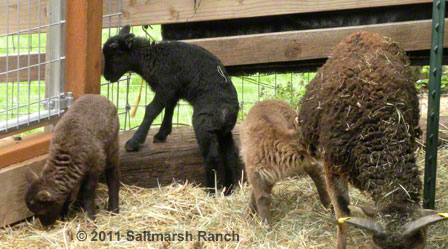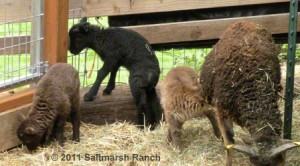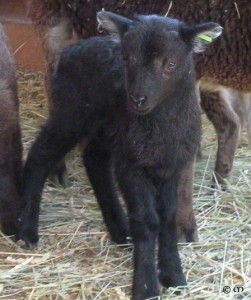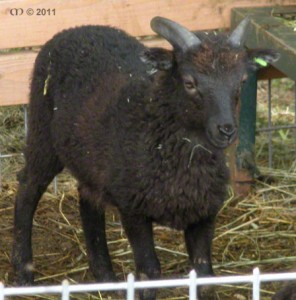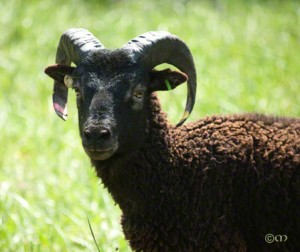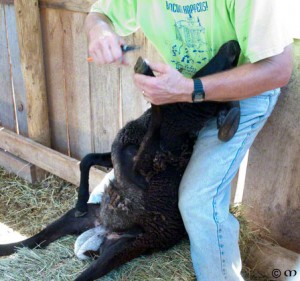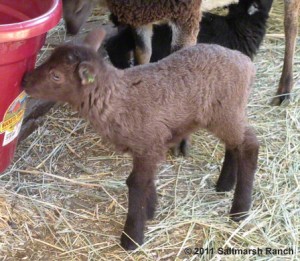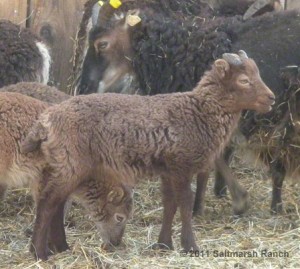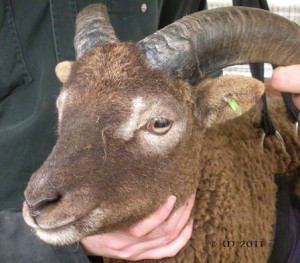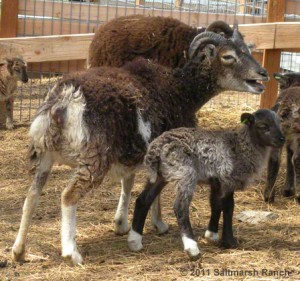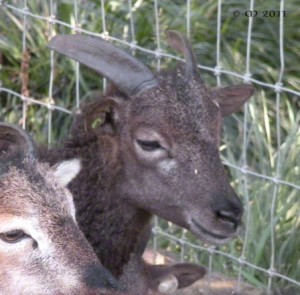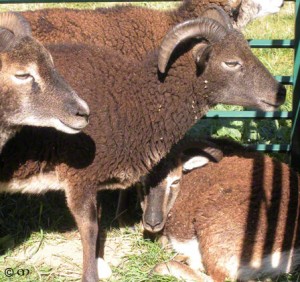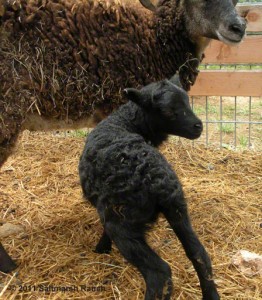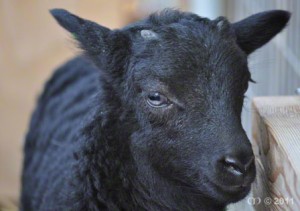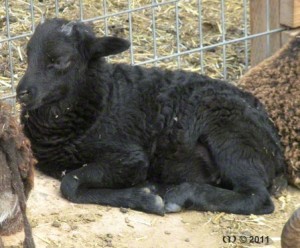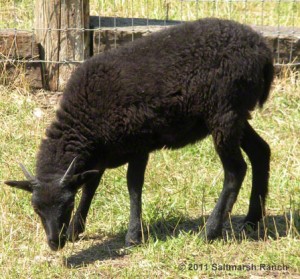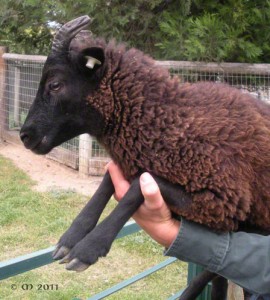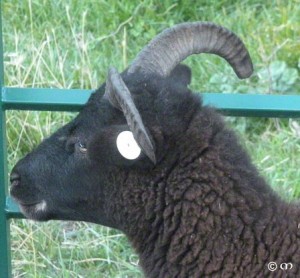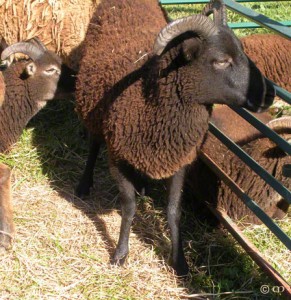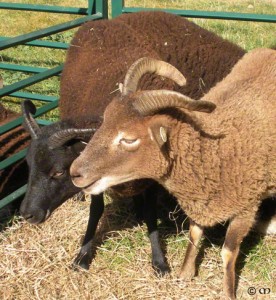More new colors and patterns in British Soay sheep: AI year two
The second in a three-part series
Part I: our 2008 AI lambs, posted on March 10, 2011
Part III: more new colors in our 2010 lambs, posted on March 14, 2011
Once Norris sired two uniform dark charcoal British Soay lambs in 2008, we figured that was it for new colors and patterns from the AI project. Wrong! Spring 2009 brought more color surprises.
First came triplets, just like last year, this time from Keverne by Mustard. But instead of three tan lambs (remember Mustard is light phase) or three plain brown lambs (Keverne is plain brown), out popped a black, a tan, and a chocolate, a veritable Soay rainbow!
Dora’s face shows some of the ash-grey look even though she is light phase, but it is subtle and I can’t seem to capture it on film. Not so with Buckley and Cantrall. There is nothing nuanced about their fleece color or their patterns.
Buckley remains nearly solid black, but he also shows a new eye marking pattern, almost like a bull’s eye around each eye.
As if Buckley’s distinctive coat coloring were not enough, when Steve up-ended him last summer to trim his hooves, we were presented with two gleaming, nearly-white balls. Buckley no doubt was trying to say to Steve, “the better to see ewes with, my dear.”
Side note: for readers over the age of 50 or so, do you remember Buckminster Fuller and Bucky Balls?
Okay, back to business. Milk-chocolate triplet Cantrall is neither typical mouflon nor the classic self-colored light pattern often referred to as “moorit.” His pattern reminded us of Vieva and Curtis in 2008, but from the light phase rather than the dark phase alternative. Cantrall’s distinguishing features from day one and as he matured were the unusual “ring” around his eyes, like Buckley’s, and a somewhat muted greyish brown fleece, as though someone rubbed his face lightly with ashes. We began to see a pattern in the new pattern.
The ash-brushed face effect showed up again more prominently in our fetching little ewe Tylesley, daughter of Borrowby x Curtis (son of Norris). We laughed every time we saw her as a lamb. She looked as though she was fixing to run away and join the circus clowns. But Tylesley soon morphed into an elegant grey ewe with long horns in addition to her ash-grey face.
Our 2009 lambing season ended, or so we thought, with the arrival of Kiger’s conventionally-bred ram lamb on May 8, 2009. We particularly regretted that Xanthoria did not lamb, since we we were short on ewe lambs and hoped for another Curtis daughter as interesting as Tylesley. Nearly a month later, on June 3rd, well after we had closed up shop on lambing and on the last possible day a lamb could arrive (148 days after Curtis returned to the bullpen), I sat in the kitchen with my morning coffee when my walkie-talkie crackled with Steve’s excited voice:
“Are you sitting down?”
“Yes.”
“Xanthoria lambed, looks like about 4:00 a.m.”
“Really? Is it another ram?”
“No, it’s a ewe lamb.”
“Terrific!”
“Are you still sitting down?”
“Yes, why?”
“She’s pitch black, just like an ink well, no shades of grey this time, just black.”
Wow. Look at what Steve found that morning:
Heywood remains almost solid black to this day. When we examined her closely as a lamb, we observed 10-20 little white hairs around her nipple buds, and we wondered whether that hint of non-self-coloration would spread. It has, and now when we up-end Heywood we find a fair amount of somewhat lighter charcoal-colored fleece on her belly and some off-white fleece around her mouth. I cannot attach genetic significance to anything, much less these new colors and patterns, and Steve is still poring over his library of articles and musty textbooks to see if these not-quite-black Soay fall into known categories. For now, we describe the appearance of Vieva, Curtis, and Heywood as uniform dark charcoal to reflect both the fact that they are not mouflon and they are not classically self-colored black. In the following pictures, you will see Heywood begin to take on just a hint of lighter fleece around her mouth and elsewhere.
She remained solid black throughout her first summer and fall:
By the time she was a year old, Heywood developed her most unique feature: a small white “dot” on her lower left lip, much like her sire Curtis. Although her fleece bleached out a lot last summer, she is still solid black at the base of her fleece, other than on her back end and parts of her belly:
I have nothing profound to say about the next picture, but it is one of my favorites for showing off color variety. Heywood on the left, and on the right is light phase Arzie, twin of Dean and daughter of Mustard:
At the conclusion of 2009 lambing, we decided to take a break from the complexities of artificial insemination and do all our breeding in fall 2009 with six of our on-site rams, including Glen (Vieva’s twin and a Norris son) and Dean (Arzie’s twin and a Mustard son). We weren’t sure we would get any more color surprises using AI sons rather than the donor rams’ sperm, but we thought we might, since we already had Tylesley from AI son Curtis. Our rams did not disappoint. For the 2010 color story, stay tuned.
For now …
